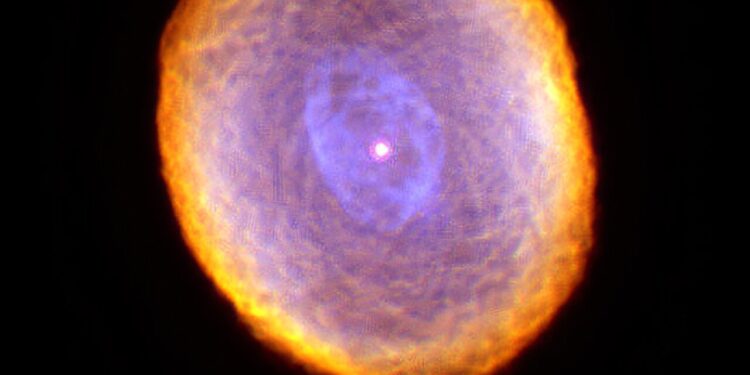Balling like a multiple facets jewelry, the planetary nebula IC418 is around 2,000 light years from the earth in the Lepus constellation. In this image, the Hubble telescope reveals remarkable textures weaving through the nebula. Their origin, however, is still uncertain. Credit: NASA / ESA and the Hubble Heritage Team (STSCI / AUA)
For the first time, scientists directly followed the slow transformation of a dying star in more than a century – revolutionary that he warms more quickly than any other typical star ever observed.
Research, published today Astrophysical newspaper lettersfollows 130 years of changes in the planetary nebula “Spirograph” IC418 – a shell of gas and brilliant dust rejected by a dying star at around 4000 light years from the earth.
By assembling observations dating from 1893 when astronomers recorded the nebula for the first time through a telescope until today, scientists have found the signing green light from the nebula, emitted by oxygen atoms, developed approximately 2.5 times stronger since victorian astronomers studied it for the first time.
This change is driven by the increase in the temperature of the central star, which has increased by around 3,000 ° C since 1893, or about 1,000 ° C every 40 years. By way of comparison, the sun has increased the same quantity during its training, but took 10 million years to do so.
However, although the star heats faster than ever, it is even slower than the last models had predicted it. This calls into question the current theories of the way the stars age and die, and can force astronomers to rethink stars capable of producing carbon – the essential element in life.
“We often do not know the scientific data obtained for a long time in the past. In this case, this data has revealed the fastest evolution of a typical star that has been seen directly. The past shows that the sky is not as immutable as we think,” explains the main researcher, Professor Albert Zijlstra.
A planetary nebula marks one of the last stages of the life of a star. While the kernel of the star becomes unstable, it launches its outer layers in space. The remaining heart heats up quickly, boosting the surrounding gas and dust to form beautiful structures. In the case of IC418, this creates a complex swirling structure, winning its nickname “The Spirograph Nebula”. Our sun will suffer the same fate in about 5 billion years.
While planetary nebulae generally evolve slowly, the researchers discovered that IC418 evolves quickly enough to follow during a human life.
This makes it the most prolonged and fastest transformation ever recorded in a planetary nebula, and perhaps any star.
The team examined 130 years of observations of a wide range of telescopes – human ocular measures in the late 1800s in today’s advanced technologies. They checked, calibrated and combined the data before comparing it with detailed stellar evolution models. This allowed them to measure the heating rate of the star, to determine its current mass and even to estimate the mass of the star before starting its transformation.
The results offer a rare overview of the evolution of planetary nebulae and suggest that the night sky can change much faster than we usually think.
The co-author, Professor Quentin Parker of the University of Hong Kong, said: “We believe that this research is important because it offers unique and direct proof of the evolution of central stars of planetary nebulae. It will encourage us to rethink some of our existing models of stellar life cycles.
“It was a very joint effort – collect, verify and carefully analyze more than a century of astronomical data, then merge this with stellar evolutionary models. It is a difficult process that goes far beyond simple observation, and we are grateful for the opportunity to contribute to our field in this way.”
More information:
Albert A. Zijlstra et al, the secular evolution of the planetary nebula IC 418 and its implications for the formation of carbon stars, Astrophysical newspaper letters (2025). DOI: 10.3847 / 2041-8213 / ADF62B
Provided by the University of Manchester
Quote: Astronomers capture a record evolution of 130 years of a dying star (2025, August 20) recovered on August 20, 2025 from
This document is subject to copyright. In addition to any fair program for private or research purposes, no part can be reproduced without written authorization. The content is provided only for information purposes.



